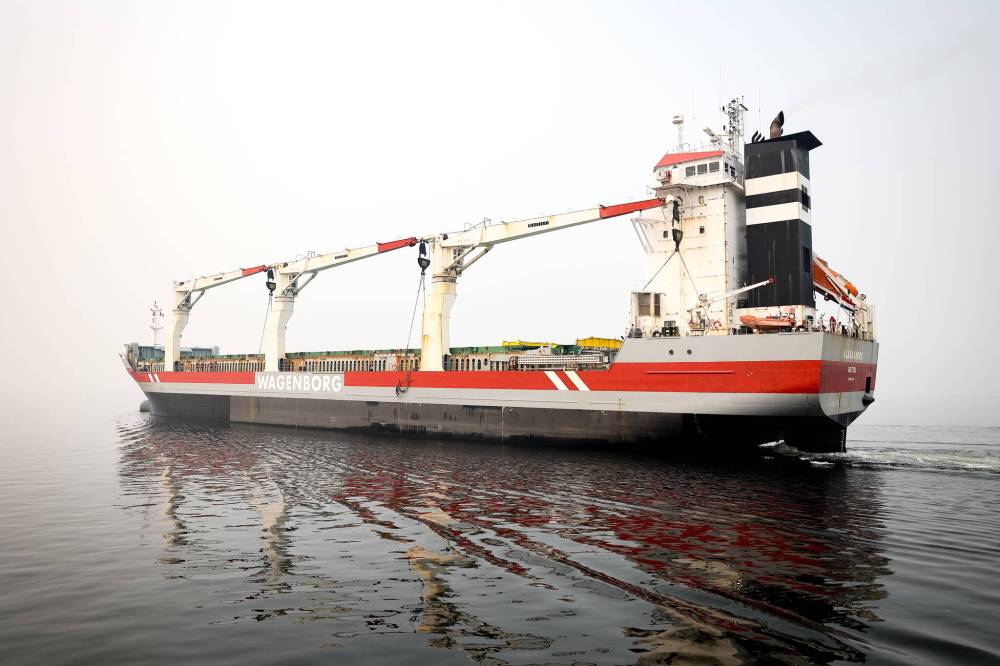
The Port of Churchill loaded its first shipment of critical minerals in more than 20 years on Friday onto a Dutch ice-class vessel headed for Europe.
It is hoped that it will demonstrate to the industry at large that the port has the capacity to handle such materials and that it can be part of an economically viable supply chain.
Officials at HudBay Minerals Inc. believe that it’s a shipping option it can use in the future.

SUPPLIED
For the first time in over two decades, an export shipment of Critical Minerals has departed from the Port of Churchill.
It was HudBay’s 10,000 metric tonnes of zinc concentrate that was loaded onto 114 rail cars from the company’s Lalor Mine in Snow Lake that was loaded on Friday, heading to a smelter in Europe.
Jon Douglas, vice-president and treasurer of HudBay Minerals, said, “Our little bit of zinc concentrate won’t make or break the port’s business. But if they can get other commodities and more resupply work (to the Kivalliq region of Nunavut)… with a lot bigger tonnes potentially involved, that would be wonderful for these guys.”
Arctic Gateway Group (AGG), the Indigenous and northern community-owned company that operates Hudson Bay Railway and the Port of Churchill, has put in lots of work this year to make this shipment possible.
Including construction of a mineral storage facility, this year’s capital spending of about $60 million included new equipment, including cargo container handlers, skid feeders, expansion hoppers, loaders and transfer conveyors, as well as 125,000 rail tie replacements, 800,000 feet of resurfacing, several crossing rehabilitations, turnout replacements and various bridge improvements on the rail line.
Mike Spence, longtime mayor of Churchill and chair of AGG, said the mineral shipment is a breakthrough.
“We’re shipping northern Manitoba product going through a Manitoba port,” he said. “This is cool. It’s great.”
Spence said there is still plenty of work to do, but believes it’s a milestone for AGG. The last time the port handled any mineral product was a shipment of copper concentrate into Churchill more than 20 years ago.
Some of the evidence of the impact of the $60 million investment in infrastructure this year, including $30 million from the province was on display on Friday.
Lisa Naylor, the provincial transportation minister, said there is a lot of hopefulness about the possibilities going forward.
“This shows that AGG is able to diversify the commodities they will be shipping,” she said. “We are seeing this as having created a proof of concept demonstration of the port’s ability to support critical mineral supply chains.”
Douglas said it is entirely possible that HudBay will ship more of its Manitoba mineral production out of Churchill.
“There are always different places to ship material. There are zinc smelters in Canada,” he said. “The smelters in Europe have been customers of ours for the last two and a half years and we will continue to ship to them under contract for a couple of years yet.”
He said shipping out of Churchill makes a lot of sense, even though there are some impediments like the fact the port is not open 12 months of the year and it requires the additional expense of booking ice class vessels.
“We’re happy to continue the relationship with the Arctic Gateway folks,” he said. “Of the 60,000 tonnes per year of zinc concentrate that we make, perhaps 20,000 could go out of the port in any given year.”
Diane Gray, the deputy minister of the federal department of PrairiesCan (formerly Western Economic Diversification) said the world is fixated on critical minerals and there are a lot of those assets underground in western Canada.
“The shipment demonstrates first to HudBay that this is not only feasible but an efficient supply chain for export of their minerals,” she said. “But it does the same for other mining companies as well.”
Spence emphasized the that the operation is an example of economic reconciliation and that the Indigenous-owned company is really the only enterprise in northern Canada doing this kind of work.
“It also couldn’t have happened without the support of the federal and provincial governments,” he said.
AGG officials believe when its capital investment work on the port and rail infrastructure is done in 2028 it could reduce shipping time and costs for key international markets, generate more than $1 billion annually in associated economic activity for the Canadian economy, support more than 5,500 jobs annually including indirect jobs and provide Canada with a multi-use infrastructure that enables a stronger assertion of Canada’s sovereignty in the Arctic.
martin.cash@freepress.mb.ca

Martin Cash
Reporter
Martin Cash is a business reporter/columnist who’s been on that beat for the Free Press since 1989. He’s a graduate of the University of Toronto and studied journalism at Ryerson (now Toronto Metropolitan University). Read more about Martin.
Every piece of reporting Martin produces is reviewed by an editing team before it is posted online or published in print — part of the Free Press‘s tradition, since 1872, of producing reliable independent journalism. Read more about Free Press’s history and mandate, and learn how our newsroom operates.
Our newsroom depends on a growing audience of readers to power our journalism. If you are not a paid reader, please consider becoming a subscriber.
Our newsroom depends on its audience of readers to power our journalism. Thank you for your support.



